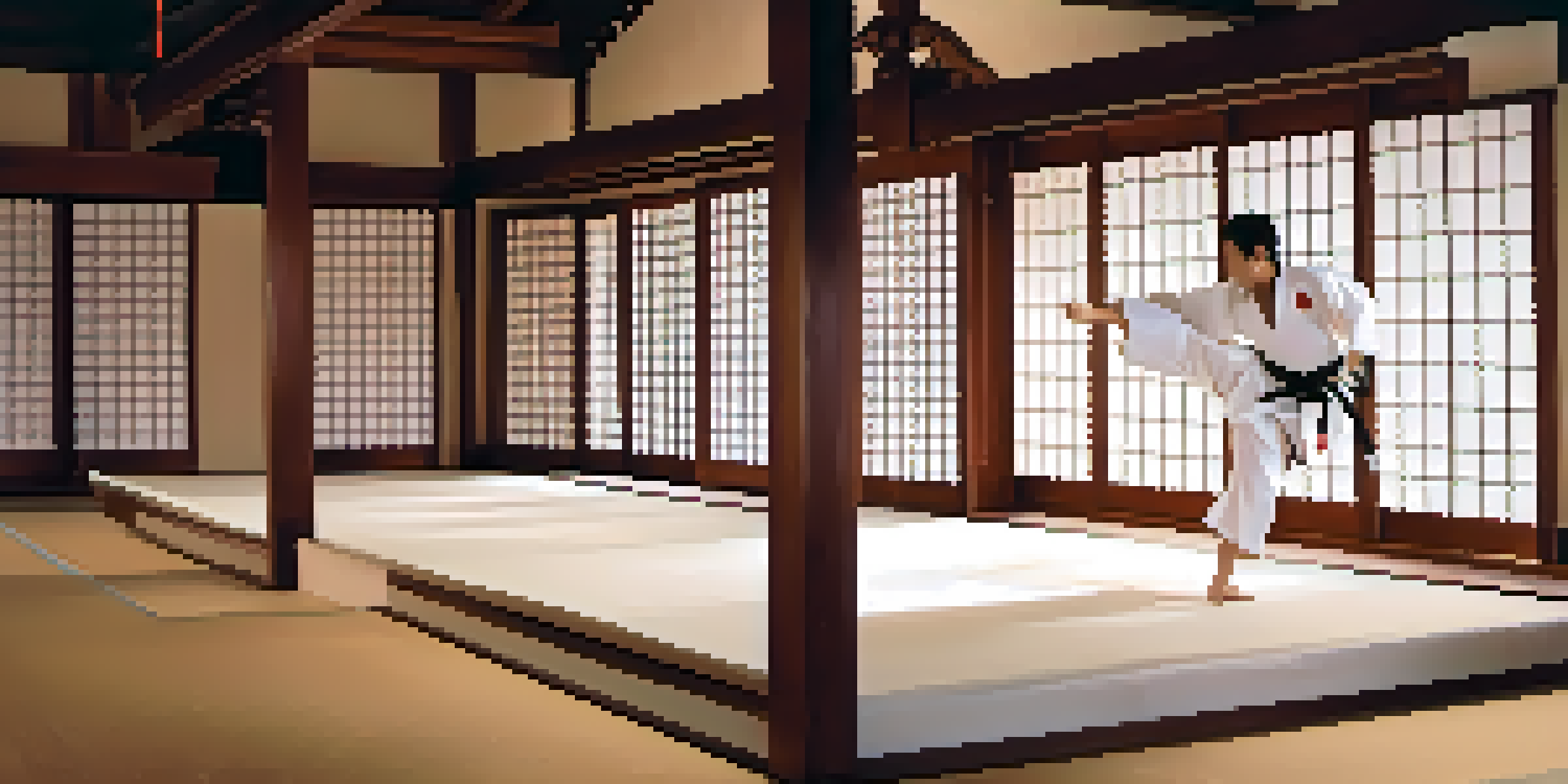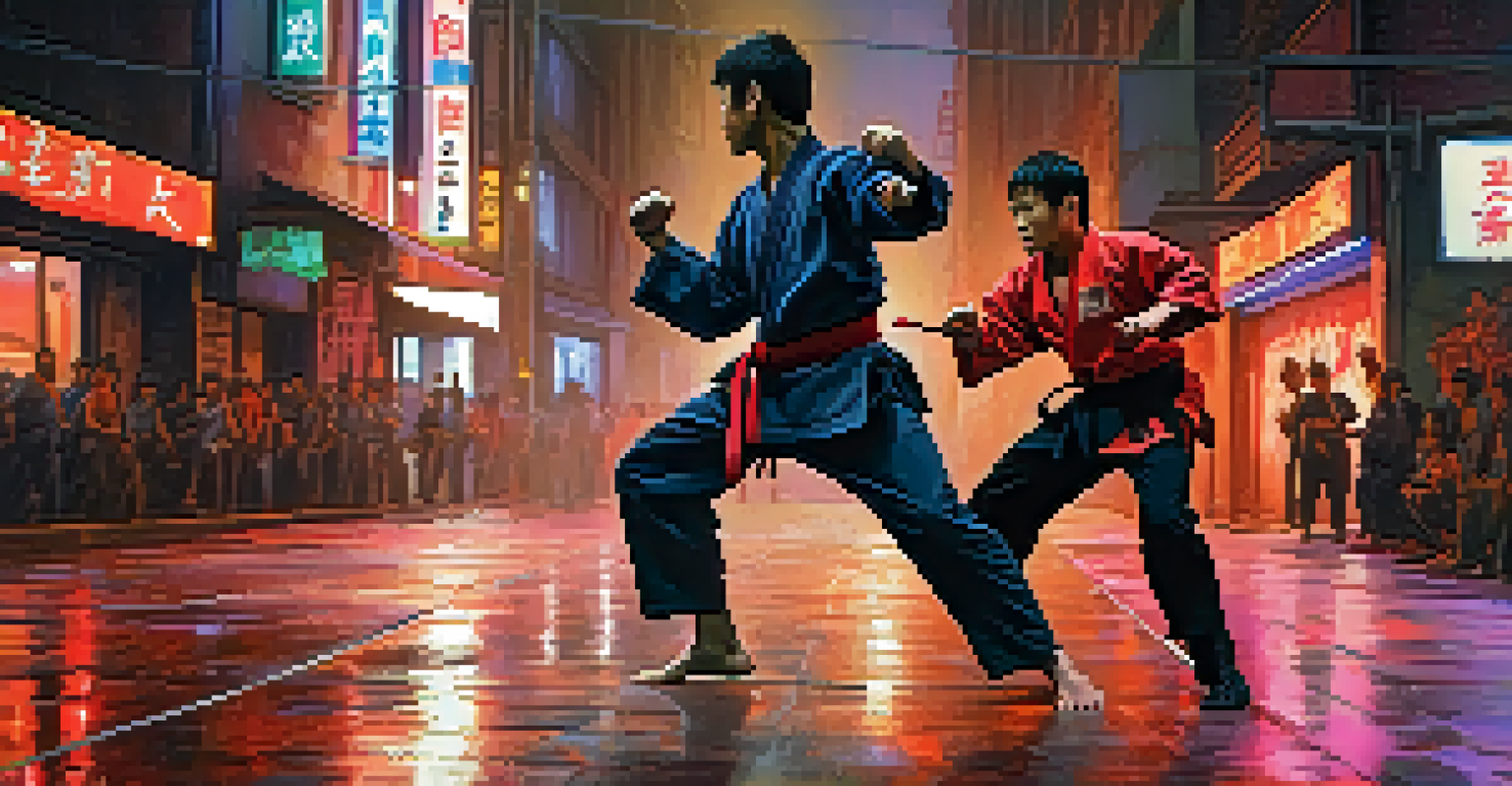The Art of Choreography: Crafting Martial Arts for Film

Understanding the Role of Choreography in Martial Arts Films
Choreography is the backbone of martial arts films, transforming physical skills into captivating visuals. It’s not just about fighting; it’s about storytelling through movement. Each kick, punch, and dodge is meticulously planned to convey emotions and character arcs, making the audience feel the intensity of the conflict.
Choreography is the art of making a dance out of fighting.
The choreography must align with the film's narrative and tone, creating a seamless blend between action and story. For instance, a dramatic showdown might require slower, more deliberate movements to heighten tension, while a light-hearted scene could incorporate playful, fast-paced exchanges. This thoughtful approach keeps viewers engaged and invested in the characters.
Additionally, effective choreography considers the unique styles of the martial arts being portrayed. From the graceful movements of Tai Chi to the explosive energy of Muay Thai, each discipline brings its own flavor. When executed well, choreography not only entertains but also educates the audience about martial arts.
The Process: From Concept to Execution
Creating martial arts choreography begins with a clear vision of the scene. Directors and choreographers collaborate to outline the desired emotions and outcomes, often referencing similar scenes or traditional martial arts practices for inspiration. This brainstorming phase is crucial, as it sets the foundation for the entire sequence.

Once the concept is established, the choreographer crafts the moves, often using storyboards or sketches to visualize the sequence. This involves breaking down each action, ensuring that the movements flow naturally and enhance the narrative. It’s akin to composing a symphony, where each note must harmonize with the others to create a masterpiece.
Choreography: Art of Storytelling
Choreography in martial arts films is essential for conveying emotions and character arcs through meticulously planned movements.
Rehearsals come next, where actors practice the choreography until it feels second nature. This is where adjustments are made, allowing for a more organic performance. The final execution on camera captures the hard work, resulting in a stunning portrayal of martial arts that resonates with the audience.
The Importance of Safety in Martial Arts Choreography
Safety is a top priority in martial arts choreography, ensuring that performers can execute complex moves without injury. Choreographers must design sequences that allow for safe execution while still maintaining excitement. This often means incorporating protective gear during practice and using techniques that minimize risk.
Action is not only about what you do but also how you do it.
Injuries can happen even with the best precautions, so communication between performers and choreographers is key. They must understand each other's limits and capabilities, allowing for adjustments that keep everyone safe. This collaboration fosters an environment where creativity can flourish without compromising safety.
Moreover, incorporating safety measures doesn’t detract from the intensity of the performance. With proper training and precautions, performers can deliver heart-pounding action that thrills audiences while ensuring their well-being. After all, a safe set is a happy set, which translates to better performances.
Cultural Representation in Martial Arts Choreography
Martial arts films often draw from rich cultural traditions, making authentic representation vital in choreography. Choreographers must research the specific styles and techniques that reflect the culture accurately, avoiding stereotypes that can misrepresent martial arts. This respect for cultural nuances adds depth to the film and honors the traditions being portrayed.
For example, incorporating specific stances, movements, and rituals from a particular martial art can enhance the authenticity of a scene. This not only enriches the viewer’s experience but also educates them about the martial arts' origins and significance. When done right, this level of detail can elevate a film from being just entertainment to a cultural exploration.
Safety First in Fight Scenes
Prioritizing safety in choreography ensures that performers can execute complex moves without injury while still delivering thrilling performances.
Cultural representation also extends to the casting of performers. When martial artists from the relevant backgrounds are involved, it adds a layer of authenticity that resonates with audiences. This commitment to genuine representation helps foster a deeper appreciation for the art form and its roots.
The Influence of Technology on Choreography
Technology has significantly impacted the way martial arts choreography is created and executed in film. With the help of computer-generated imagery (CGI) and advanced filming techniques, choreographers can push the boundaries of what’s possible. This allows for stunning visuals that might not be achievable through traditional methods alone.
For instance, slow-motion effects can enhance the beauty of a well-executed kick, emphasizing the skill and precision of the performer. Additionally, motion capture technology enables choreographers to create intricate sequences that can be animated or incorporated into video games, expanding the reach of martial arts choreography beyond traditional film.
However, while technology provides exciting opportunities, it’s essential not to rely solely on it. The heart of martial arts choreography lies in the physical performance itself, and technology should enhance rather than overshadow the artistry. Striking the right balance ensures that the choreography remains engaging and authentic.
Iconic Martial Arts Choreography in Film History
Throughout film history, certain martial arts sequences have become iconic, influencing generations of filmmakers and fans. Films like 'Enter the Dragon' and 'The Matrix' showcased groundbreaking choreography that redefined action cinema. These sequences not only entertained but also inspired a deeper appreciation for martial arts as a legitimate art form.
The choreography in 'Crouching Tiger, Hidden Dragon' is another prime example, where the fluid movements and aerial techniques blended seamlessly with the film’s narrative. This innovative approach captivated audiences worldwide and earned numerous accolades, proving that martial arts choreography can elevate storytelling to new heights.
Cultural Authenticity Matters
Authentic representation in martial arts choreography enriches films and honors the cultural roots of the art form.
These iconic scenes serve as a testament to the creativity and skill of choreographers who have dedicated themselves to the craft. They remind us that choreography is not just about fighting; it's about creating memorable moments that leave a lasting impact on viewers.
The Future of Martial Arts Choreography in Film
As filmmaking continues to evolve, so does the art of martial arts choreography. With the rise of streaming platforms and global audiences, there’s a growing demand for fresh and innovative choreography that resonates across cultures. This presents exciting opportunities for choreographers to experiment with new styles and techniques, pushing the boundaries of traditional martial arts.
Moreover, the increasing collaboration between different cultures in film opens up avenues for cross-pollination of ideas. Choreographers are now blending various martial arts styles, creating unique fusion sequences that capture the essence of multiple traditions. This not only enriches the choreography but also promotes a sense of global unity through the art form.

Ultimately, the future of martial arts choreography lies in its ability to adapt and innovate while honoring its roots. As filmmakers and choreographers continue to explore new horizons, audiences can look forward to exhilarating performances that celebrate the beauty and complexity of martial arts in ways we’ve yet to imagine.